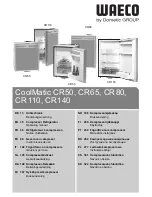
Instructions for Use
33
Shelf (1)
(number depends on the model)
Shelf can be optionally placed on the guides
inside the appliance. It is protected against
pulling out. If you want to remove it, slightly lift
up the back part and pull it out.
Glass shelves (some models only have them)
are protected with plastic spacers. Before
pulling the shelf out, spacers must be moved
towards you. Spacers can be also removed,
however, it is better to keep them for any later
transport.
Quickly perishable food should be stored on the
back i.e. the coldest part of the shelves.
Bottle rack
(in some models only)
Bottle rack (number depends on model) is
intended for storing the bottles. There are two
installation positions available (horizontal or
lifted in the front) thus enabling the positioning
of bottles on the stopper as well. It is protected
against pulling out. If you want to pull it out,
simply lift its rear part and pull it towards you.
Warning!
If the door contains storing shelves, install the
rack in such position that the length of the
bottles will not hinder the closing of the door.
The rack may carry 9 bottles of 0,75 l or more
at the maximum (total weight max. 13 kg) –
note the label underneath the thermostat box
inside the appliance.
Defrost Water Outlet (2)
Regularly check the defrost water outlet and the
channel, because they should never be clogged
(as for example with food rests). If clogged, use
a plastic straw and clean it.
Fruit and Vegetable Container (3)
The container is on the bottom under the glass
shelf and is used mainly for storing fruits and
vegetables. It provides adequate humidity
which has favourable effect on food stored.
Door Liner
The door liner consists of various shelves or
holders used for storing eggs, cheese, butter
and yogurt as well as other smaller packages,
tubes, cans etc. The lower shelf is used for
storing bottles.
Illumination in the Interior of the
Refrigerator
The light for illuminating the interior of the
appliance is on, when the door is opened. The
operation of the light does not depend on the
position of the thermostat knob.
NOTE:
•
The appliance can be equipped with various
accesories, depending on the model of the
appliance.
•
Various accesories (spice container, tube
holder or additional shelves and drawer
partitions) can be bought in authorized
centres.
Operation Control
The appliance is controlled with thermostat
knob, situated in the right upper part inside the
appliance. Turn the knob clockwise from
STOP
(0)
position towards
7
and backwards.
Temperature Selection
•
Higher settings on the knob (towards
7
)
mean lower temperatures (colder) in all three
compartments of the appliance. At higher
settings temperature in the interior of the
appliance may even drop below 0°C. When
the ambient temperature is normal, we
recommend medium setting.
•
Changes of the ambient temprature affect
temperature in the interior of the appliance
(choose correct setting of the thermostat
knob).
•
In
STOP (0)
position the appliance does not
operate (the cooling system is switched off),
yet power supply is not interrupted (the light
is on, when you open the refrigerator door).

































